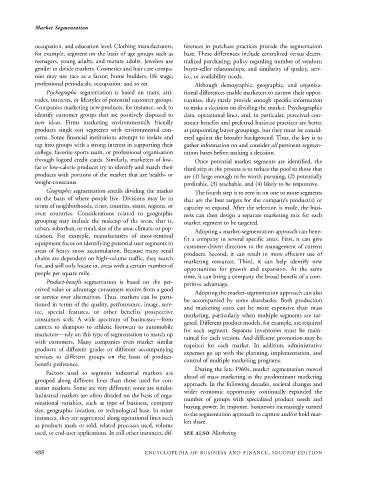Page 511 - Encyclopedia of Business and Finance
P. 511
eobf_M 7/5/06 3:15 PM Page 488
Market Segmentation
occupation, and education level. Clothing manufacturers, ferences in purchase practices provide the segmentation
for example, segment on the basis of age groups such as base. These differences include centralized versus decen-
teenagers, young adults, and mature adults. Jewelers use tralized purchasing; policy regarding number of vendors;
gender to divide markets. Cosmetics and hair care compa- buyer-seller relationships; and similarity of quality, serv-
nies may use race as a factor; home builders, life stage; ice, or availability needs.
professional periodicals, occupation; and so on. Although demographic, geographic, and organiza-
Psychographic segmentation is based on traits, atti- tional differences enable marketers to narrow their oppor-
tudes, interests, or lifestyles of potential customer groups. tunities, they rarely provide enough specific information
Companies marketing new products, for instance, seek to to make a decision on dividing the market. Psychographic
identify customer groups that are positively disposed to data, operational lines, and, in particular, perceived con-
new ideas. Firms marketing environmentally friendly sumer benefits and preferred business practices are better
products single out segments with environmental con- at pinpointing buyer groupings, but they must be consid-
cerns. Some financial institutions attempt to isolate and ered against the broader background. Thus, the key is to
tap into groups with a strong interest in supporting their gather information on and consider all pertinent segmen-
college, favorite sports team, or professional organization tation bases before making a decision.
through logoed credit cards. Similarly, marketers of low- Once potential market segments are identified, the
fat or low-calorie products try to identify and match their third step in the process is to reduce the pool to those that
products with portions of the market that are health- or are (1) large enough to be worth pursuing, (2) potentially
weight-conscious. profitable, (3) reachable, and (4) likely to be responsive.
Geographic segmentation entails dividing the market The fourth step is to zero in on one or more segments
on the basis of where people live. Divisions may be in that are the best targets for the company’s product(s) or
terms of neighborhoods, cities, counties, states, regions, or capacity to expand. After the selection is made, the busi-
even countries. Considerations related to geographic ness can then design a separate marketing mix for each
grouping may include the makeup of the areas, that is, market segment to be targeted.
urban, suburban, or rural; size of the area; climate; or pop-
Adopting a market-segmentation approach can bene-
ulation. For example, manufacturers of snow-removal
fit a company in several specific areas. First, it can give
equipment focus on identifying potential user segments in customer-driven direction to the management of current
areas of heavy snow accumulation. Because many retail
products. Second, it can result in more efficient use of
chains are dependent on high-volume traffic, they search marketing resources. Third, it can help identify new
for, and will only locate in, areas with a certain number of
opportunities for growth and expansion. At the same
people per square mile.
time, it can bring a company the broad benefit of a com-
Product-benefit segmentation is based on the per- petitive advantage.
ceived value or advantage consumers receive from a good
Adopting the market-segmentation approach can also
or service over alternatives. Thus, markets can be parti- be accompanied by some drawbacks. Both production
tioned in terms of the quality, performance, image, serv-
and marketing costs can be more expensive than mass
ice, special features, or other benefits prospective
marketing, particularly when multiple segments are tar-
consumers seek. A wide spectrum of businesses—from geted. Different product models, for example, are required
camera to shampoo to athletic footwear to automobile
for each segment. Separate inventories must be main-
marketers—rely on this type of segmentation to match up
tained for each version. And different promotion may be
with customers. Many companies even market similar
required for each market. In addition, administrative
products of different grades or different accompanying
expenses go up with the planning, implementation, and
services to different groups on the basis of product- control of multiple marketing programs.
benefit preference.
During the late 1960s, market segmentation moved
Factors used to segment industrial markets are
ahead of mass marketing as the predominant marketing
grouped along different lines than those used for con- approach. In the following decades, societal changes and
sumer markets. Some are very different; some are similar.
wider economic opportunity continually expanded the
Industrial markets are often divided on the basis of orga- number of groups with specialized product needs and
nizational variables, such as type of business, company
buying power. In response, businesses increasingly turned
size, geographic location, or technological base. In other
to the segmentation approach to capture and/or hold mar-
instances, they are segmented along operational lines such ket share.
as products made or sold, related processes used, volume
used, or end-user applications. In still other instances, dif- SEE ALSO Marketing
488 ENCYCLOPEDIA OF BUSINESS AND FINANCE, SECOND EDITION

